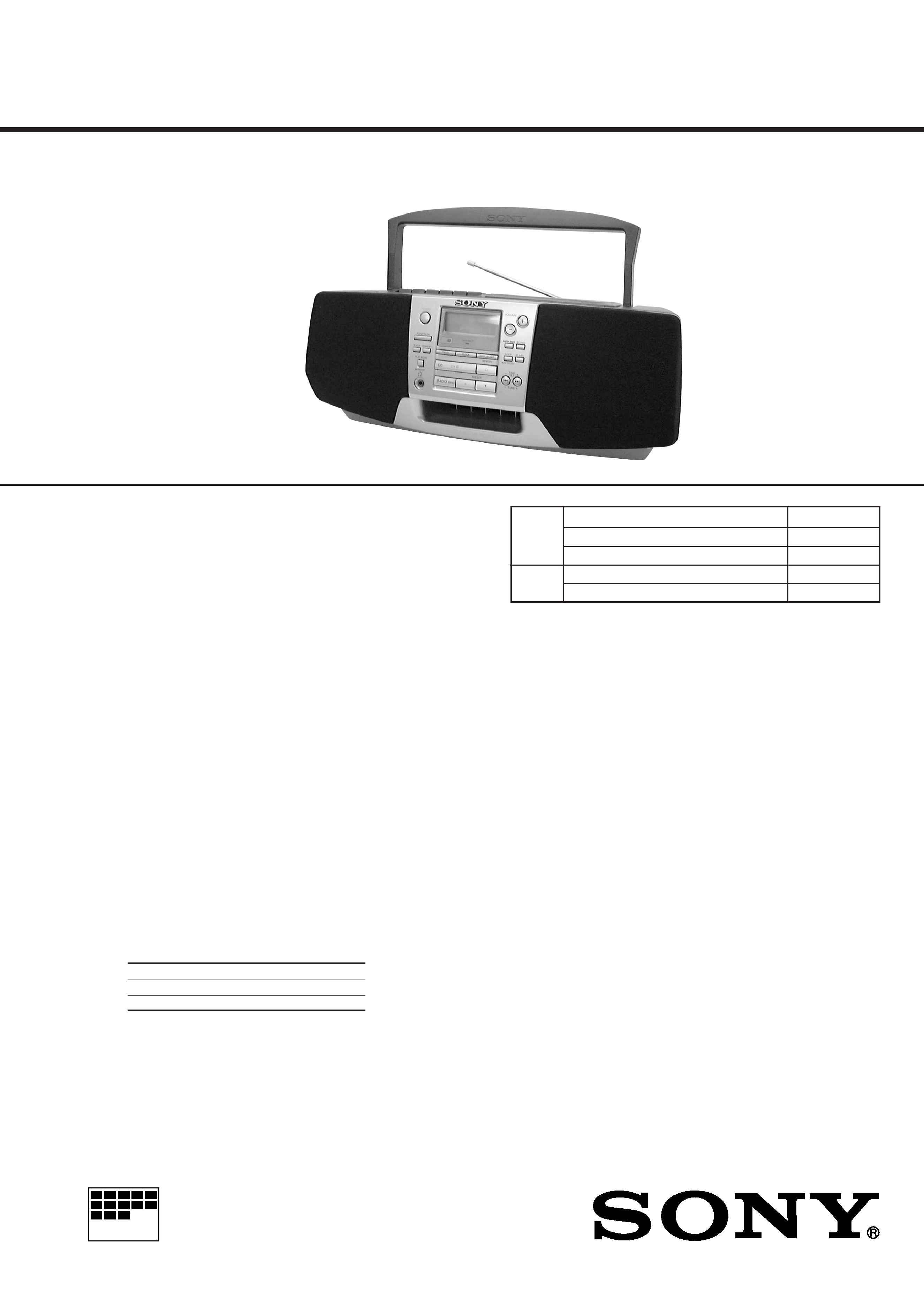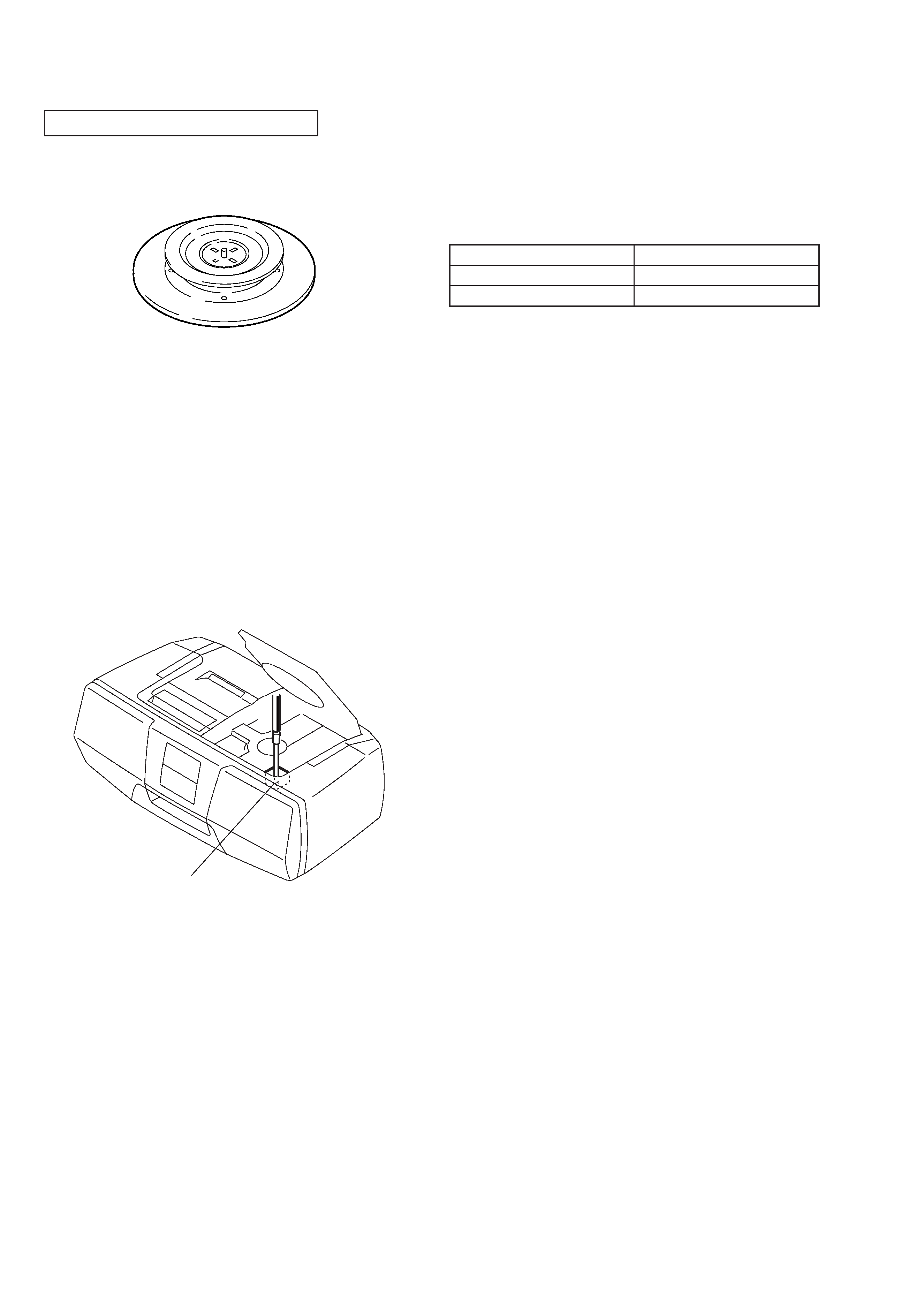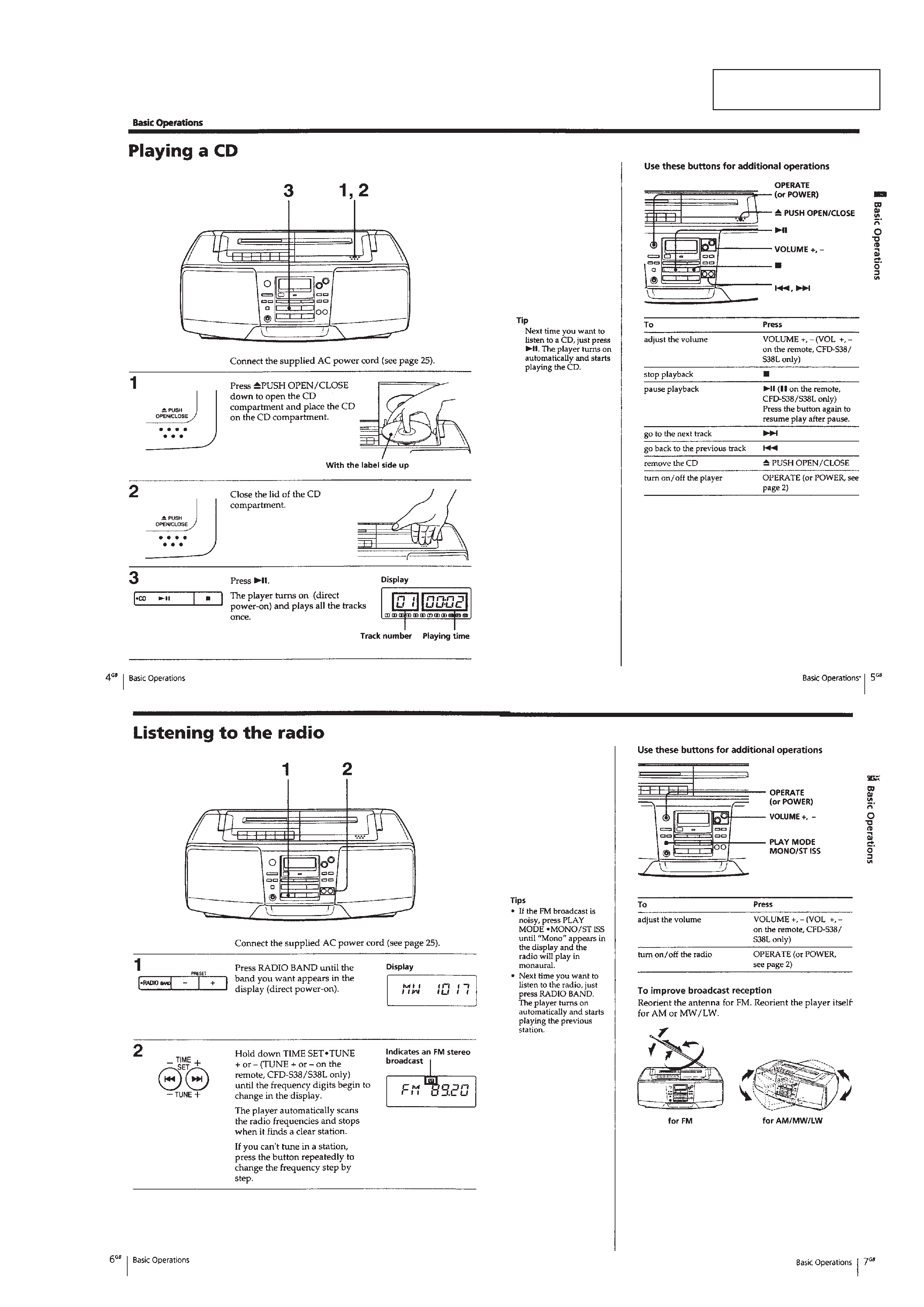
1
CD
Model Name Using Similar Mechanism PMC-D307L
Section
CD Mechanism Type
KSM-213CDM
Optical Pick-up Name
KSS-213C
TC
Model Name Using Similar Mechanism CFD-V10
Section Tape Transport Mechanism Type
MF-V10-117
SERVICE MANUAL
AEP Model
UK Model
CFD-S38L
CD RADIO CASSETTE-CORDER
CD player section
System
Compact disc digital audio system
Laser diode properties
Material: GaAlAs
Wave length: 780 nm
Emission duration: Continuous
Laser output: Less than 44.6 µW
(This output is the value measured at a distance of
about 200 mm from the objective lens surface on
the optical pick-up block with 7 mm aperture.)
Spindle speed
200 r/min (rpm) to 500 r/min (rpm) (CLV)
Number of channels
2
Frequency response
20 - 20,000 Hz +1/2 dB
Wow and flutter
Below measurable limit
Radio section
Frequency range
FM
87.6 - 107 MHz
MW
531 - 1,602 kHz
LW
153 - 279 kHz
IF
FM: 10.7 MHz
MW/LW: 450 kHz
Aerials
FM: Telescopic aerial
MW/LW: Built-in ferrite bar aerial
SPECIFICATIONS
Continued on next page
Cassette-corder section
Recording system
4-track 2 channel stereo
Fast winding time
Approx. 120 sec. with Sony cassette C-60
Frequency response
TYPE I (normal): 70 - 13,000 Hz
General
Speaker
Full range: 10 cm (4 in.) dia.,
6 ohms, cone type (2)
Outputs
Headphones jack (stereo minijack)
For 16 - 68 ohms impedance headphones
Power requirements
For CD radio cassette-corder:
230 V AC, 50 Hz
9 V DC, 6 R20 (size D) batteries
For memory back-up:
6 V DC, 4 R6 (size AA) batteries
For remote control:
3 V DC, 2 R6 (size AA) batteries
Power consumption
AC 25 W
MICROFILM
Ver 1.0 1999. 03

2
SAFETY-RELATED COMPONENT WARNING!!
COMPONENTS IDENTIFIED BY MARK
! OR DOTTED LINE
WITH MARK
! ON THE SCHEMATIC DIAGRAMS AND IN
THE PARTS LIST ARE CRITICAL TO SAFE OPERATION.
REPLACE THESE COMPONENTS WITH SONY PARTS WHOSE
PART NUMBERS APPEAR AS SHOWN IN THIS MANUAL OR
IN SUPPLEMENTS PUBLISHED BY SONY.
Battery life
For CD radio cassette-corder:
FM recording
Sony R20P: approx. 3.5 h
Sony alkaline LR20: approx. 10 h
Tape playback
Sony R20P: approx. 1.5 h
Sony alkaline LR20: approx. 5 h
CD playback
Sony R20P: approx. 1 h
Sony alkaline LR20: approx. 4 h
Dimensions
Approx. 420
× 156 × 262 mm (w/h/d)
(incl. projecting parts)
Mass
Approx. 4.7 kg (incl. batteries)
Supplied accessories
AC power cord (1)
Remote control RMT-CS38A (1)
Design and specifications are subject to change without
notice.
CAUTION
Use of controls or adjustments or performance of proce-
dures other than those specified herein may result in haz-
ardous radiation exposure.
Flexible Circuit Board Repairing
· Keep the temperature of the soldering iron around 270°C during
repairing.
· Do not touch the soldering iron on the same conductor of the
circuit board (within 3 times).
· Be careful not to apply force on the conductor when soldering
or unsoldering.
Notes on Chip Component Replacement
· Never reuse a disconnected chip component.
· Notice that the minus side of a tantalum capacitor may be dam-
aged by heat.
NOTES ON HANDLING THE OPTICAL PICK-UP BLOCK
OR BASE UNIT
The laser diode in the optical pick-up block may suffer electrostatic
breakdown because of the potential difference generated by the
charged electrostatic load, etc. on clothing and the human body.
During repair, pay attention to electrostatic breakdown and also use
the procedure in the printed matter which is included in the repair
parts.
The flexible board is easily damaged and should be handled with
care.
NOTES ON LASER DIODE EMISSION CHECK
The laser beam on this model is concentrated so as to be focused on
the disc reflective surface by the objective lens in the optical pick-
up block. Therefore, when checking the laser diode emission,
observe from more than 30 cm away from the objective lens.
This Compact Disc player is
classified as a CLASS 1
LASER product.
The CLASS 1 LASER
PRODUCT label is located
on the bottom exterior.

3
TABLE OF CONTENTS
1. SERVICING NOTES ......................................................... 4
2. GENERAL
Playing a CD ........................................................................... 5
Listening to the radio ............................................................... 5
Playing a tape .......................................................................... 6
Recording on a tape ................................................................. 6
3. DISASSEMBLY
3-1. Lid, Battery Case ................................................................. 7
3-2. Cabinet Assy, Front ............................................................. 7
3-3. Wires ................................................................................... 8
3-4. Transformer, Power ............................................................. 8
3-5. Antenna, Telescopic ............................................................ 9
3-6. Tuner Board ......................................................................... 9
3-7. Cabinet (Upper) Assy ........................................................ 10
3-8. Main Board ....................................................................... 10
3-9. CD Mechanism Block ....................................................... 11
3-10. Tape Mechanism Block ..................................................... 11
4. MECHANICAL ADJUSTMENTS ............................... 12
5. ELECTRICAL ADJUSTMENTS
Tape Section .......................................................................... 12
Tuner Section ......................................................................... 13
CD Section ............................................................................ 14
6. DIAGRAMS
6-1. IC Pin Description ............................................................. 15
6-2. Circuit Boards Location .................................................... 16
6-3. Block Diagram CD Section ......................................... 17
6-4. Block Diagram Main Section ...................................... 19
6-5. Schematic Diagram Tuner Section .............................. 21
6-6. Printed Wiring Board Tuner Section ........................... 23
6-7. Printed Wiring Board Control Section ........................ 24
6-8. Printed Wiring Boards Main Section .......................... 25
6-9. Schematic Diagram Main Section (1/3) ...................... 27
6-10. Schematic Diagram Main Section (2/3) ...................... 29
6-11. Schematic Diagram Main Section (3/3) ...................... 31
6-12. Printed Wiring Boards Power Supply Section ............ 33
6-13. Schematic Diagram Power Supply Section ................. 35
7. EXPLODED VIEWS
7-1. Front Cabinet Section ........................................................ 40
7-2. Cabinet (Rear) Section ...................................................... 41
7-3. Cabinet (Upper) Section .................................................... 42
7-4. Tape Mechanism Section-1 ............................................... 43
7-5. Tape Mechanism Section-2 ............................................... 44
7-6. Optical Pick-up Section .................................................... 45
8. ELECTRICAL PARTS LIST ......................................... 46

4
CHUCK PLATE JIG ON REPAIRING
On repairing CD section, playing a disc without the lid (CD), use
Chuck Plate Jig.
· Code number of Chuck Plate Jig: X-4918-255-1
SECTION 1
SERVICING NOTES
LASER DIODE AND FOCUS SEARCH OPERATION
CHECK
1. Turn ON the OPERATE button and press FUNCTION button
to CD position.
2. Open the lid (CD).
3. Turn on S501 with screwdriver, etc. as following figure.
4. Press the CD
fl button.
5. Confirm the laser diode emission while observing the objecting
lens. When there is no emission, Auto Power Control circuit or
Optical Pick-up is broken.
Objective lens moves up and down three times for focus search.
S501
NOTE FOR REPLACEMENT OF Q61 AND R64 OF THE
TUNER BOARD
R64 of the tuner board has a different constant due to the different
characteristic of Q61. When replacing R64, check the type name
marking on Q61.
The repair part for Q61 is 2SK514-H only. When replacing Q61,
check the constant of R64.
Q61
R64
2SK514-H (8-729-106-07)
2.2K (1-249-421-11)
2SK514-F (Not supplied)
1.0K (1-249-417-11)

5
SECTION 2
GENERAL
This section is extracted
from instruction manual.
5
